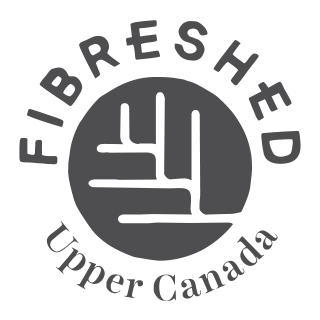Photographed by Emily Neill; Written and Researched by Becky Porlier
On a snowy December morning, I met Emily at Ruth’s weaving studio en route to Debbie’s farm. Emily was already busy taking pictures in the studio, and quizzing Ruth about her loom. [Emily has been dabbling with the idea of purchasing her own loom this entire project.] Ruth is cheery and warm. She is quick to smile and happy to chat with us about weaving, looms, fibre. She is also very encouraging of Emily’s quest.

Ruth started weaving when her children were young. As a stay-at-home Mom she accompanied her son on a grade 3 class trip to the Burlington Art Gallery, where the students were taught simple weaving. “I thoroughly enjoyed it, so I signed up for classes and now, years later, I teach the grade 3’s how to weave, as a volunteer.”
For several years she made custom, cotton, baby wraps. She liked meeting the mothers and their babies, picking colours at the table having tea and chatting. It has always been important for Ruth to connect with her community. She would get requests for wraps from elsewhere in the world and suggest that the person try to find a local weaver.
I asked if it were possible to make a living as a weaver.
“It is possible to make an income as a weaver, but you might need to have a partner with a good job.” she laughed.
Weaving is a part-time occupation that she works at every day. Getting to know her customer has morphed into getting to know the fibre farmer. “There is a connection and a different, happier mindset working with people you know.
A rhythm is set each day working between two looms. If one needs to be warped, the other’s shuttle is flying. “Switching back and forth is good. Some days I just don’t feel like weaving wool and some days I don’t feel like weaving cotton, but every day, I can still weave.”

Weaving, much like other art forms has its own personality. Ruth described beautifully how a watercolor painter adds more paint until it’s right; a photographer takes many photos to find the perfect one; “a weaver knows that if you don’t set [the loom] up right, it won’t finish right.”
Ruth also looks to the math within nature to create beautifully balanced hombres, blending colours and creating elegant patterns. “It’s the Fibonacci sequence. Weavers use these numbers and then they know it’s going to give a pleasing balance to the fabric.”
After our lovely visit, Ruth, Emily and I pile into the car and head about 130 km West to Thorndale, a small town near London, to meet Debbie.

Debbie is a retired nurse and keeps alpacas on their 10-acre family farm. She is practical, kind and we immediately feel at home. She has been on the farm for 33 years and cared for alpacas for 12 years. She grew up in Goderich, and her husband was from Woodstock. Some of the land is rented to a neighbour for cash crops, and the rest is paddocks for the animals. They have 6 different pastures to rotate through. Debbie and her husband raised Standardbred horses for many years and together, with their 2 young sons, they learned about the Alpaca (with a learning curve!)

Alpaca are very hardy animals; they rarely get sick and are very clean. Parasite pressure is low due to them using one section of the paddock only to “do their business.” Adult alpacas tend to hide an illness and often when they’re elderly, they’ll lie down and pass peacefully. Our conversation turned to what to do with livestock after they die. It’s interesting that in South America, alpaca is treated very similarly to lamb in that they are raised for both their fibre and as a food source. Since most of the alpaca in Ontario are not raised for food, there are considerations for what to do with a such a large animal. In most cases, they are cremated. It is also acceptable to bury them in a manure pile where they decompose quickly and become fertilizer. An ecological alternative.
The routine on Debbie’s farm changes with the seasons, from 45 min to do chores in the winter to much shorter time commitment in the summer.

Debbie sells her fibre out of the farm kitchen by appointment only and she does a Christmas tour with some other farmers and artisans in the area. She also offers workshops. “I always feel very satisfied, gratified when people want to purchase my yarn or something that I made with it. I really enjoy that. The customer interactions with the yarn, learning what their plans are, to see them appreciate the fibre… That’s one of the reasons I do this.”
Despite a Canada Post strike, the two women were able to connect with fibre and ideas and create 3 lusciously soft scarfs for purchase on the Etsy store.
Shop the Collection

